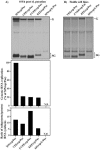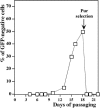Noncytopathic replication of Venezuelan equine encephalitis virus and eastern equine encephalitis virus replicons in Mammalian cells
- PMID: 15919912
- PMCID: PMC1143662
- DOI: 10.1128/JVI.79.12.7597-7608.2005
Noncytopathic replication of Venezuelan equine encephalitis virus and eastern equine encephalitis virus replicons in Mammalian cells
Abstract
Venezuelan equine encephalitis (VEE) and eastern equine encephalitis (EEE) viruses are important, naturally emerging zoonotic viruses. They are significant human and equine pathogens which still pose a serious public health threat. Both VEE and EEE cause chronic infection in mosquitoes and persistent or chronic infection in mosquito-derived cell lines. In contrast, vertebrate hosts infected with either virus develop an acute infection with high-titer viremia and encephalitis, followed by host death or virus clearance by the immune system. Accordingly, EEE and VEE infection in vertebrate cell lines is highly cytopathic. To further understand the pathogenesis of alphaviruses on molecular and cellular levels, we designed EEE- and VEE-based replicons and investigated their replication and their ability to generate cytopathic effect (CPE) and to interfere with other viral infections. VEE and EEE replicons appeared to be less cytopathic than Sindbis virus-based constructs that we designed in our previous research and readily established persistent replication in BHK-21 cells. VEE replicons required additional mutations in the 5' untranslated region and nsP2 or nsP3 genes to further reduce cytopathicity and to become capable of persisting in cells with no defects in alpha/beta interferon production or signaling. The results indicated that alphaviruses strongly differ in virus-host cell interactions, and the ability to cause CPE in tissue culture does not necessarily correlate with pathogenesis and strongly depends on the sequence of viral nonstructural proteins.
Figures








Similar articles
-
Hypervariable domain of nonstructural protein nsP3 of Venezuelan equine encephalitis virus determines cell-specific mode of virus replication.J Virol. 2013 Jul;87(13):7569-84. doi: 10.1128/JVI.00720-13. Epub 2013 May 1. J Virol. 2013. PMID: 23637407 Free PMC article.
-
The Old World and New World alphaviruses use different virus-specific proteins for induction of transcriptional shutoff.J Virol. 2007 Mar;81(5):2472-84. doi: 10.1128/JVI.02073-06. Epub 2006 Nov 15. J Virol. 2007. PMID: 17108023 Free PMC article.
-
Sindbis Virus Infection Causes Cell Death by nsP2-Induced Transcriptional Shutoff or by nsP3-Dependent Translational Shutoff.J Virol. 2018 Nov 12;92(23):e01388-18. doi: 10.1128/JVI.01388-18. Print 2018 Dec 1. J Virol. 2018. PMID: 30232189 Free PMC article.
-
[EPIDEMIOLOGIC ANALYSIS OF OUTBREAKS OF DISEASES CAUSED BY AMERICAN EQUINE ENCEPHALITIS CAUSATIVE AGENTS IN ENDEMIC REGIONS].Zh Mikrobiol Epidemiol Immunobiol. 2015 Sep-Oct;(5):103-10. Zh Mikrobiol Epidemiol Immunobiol. 2015. PMID: 26829861 Review. Russian.
-
Venezuelan Equine Encephalitis Virus Capsid-The Clever Caper.Viruses. 2017 Sep 29;9(10):279. doi: 10.3390/v9100279. Viruses. 2017. PMID: 28961161 Free PMC article. Review.
Cited by
-
New PARP gene with an anti-alphavirus function.J Virol. 2012 Aug;86(15):8147-60. doi: 10.1128/JVI.00733-12. Epub 2012 May 23. J Virol. 2012. PMID: 22623789 Free PMC article.
-
The human respiratory syncytial virus matrix protein is required for maturation of viral filaments.J Virol. 2012 Apr;86(8):4432-43. doi: 10.1128/JVI.06744-11. Epub 2012 Feb 8. J Virol. 2012. PMID: 22318136 Free PMC article.
-
A dual-antigen self-amplifying RNA SARS-CoV-2 vaccine induces potent humoral and cellular immune responses and protects against SARS-CoV-2 variants through T cell-mediated immunity.Mol Ther. 2022 Sep 7;30(9):2968-2983. doi: 10.1016/j.ymthe.2022.04.014. Epub 2022 Apr 20. Mol Ther. 2022. PMID: 35450821 Free PMC article.
-
Production of pseudoinfectious yellow fever virus with a two-component genome.J Virol. 2007 Nov;81(21):11737-48. doi: 10.1128/JVI.01112-07. Epub 2007 Aug 22. J Virol. 2007. PMID: 17715227 Free PMC article.
-
Novel Mutations in nsP2 Abolish Chikungunya Virus-Induced Transcriptional Shutoff and Make the Virus Less Cytopathic without Affecting Its Replication Rates.J Virol. 2019 Feb 5;93(4):e02062-18. doi: 10.1128/JVI.02062-18. Print 2019 Feb 15. J Virol. 2019. PMID: 30487275 Free PMC article.
References
-
- Berge, T. O., I. S. Banks, and W. D. Tigertt. 1961. Attenuation of Venezuelan equine encephalomyelitis virus by in vitro cultivation in guinea pig heart cells. Am. J. Hyg. 73:209-218.
-
- Charles, P. C., E. Walters, F. Margolis, and R. E. Johnston. 1995. Mechanism of neuroinvasion of Venezuelan equine encephalitis virus in the mouse. Virology 208:662-671. - PubMed
-
- Dal Canto, M. C., and S. G. Rabinowitz. 1981. Central nervous system demyelination in Venezuelan equine encephalomyelitis infection. J. Neurol. Sci. 49:397-418. - PubMed
Publication types
MeSH terms
Substances
Grants and funding
LinkOut - more resources
Full Text Sources
Other Literature Sources
Research Materials
Miscellaneous

